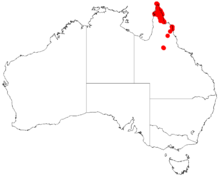| Acacia brassii | |
|---|---|
| Scientific classification | |
| Kingdom: | Plantae |
| Clade: | Tracheophytes |
| Clade: | Angiosperms |
| Clade: | Eudicots |
| Clade: | Rosids |
| Order: | Fabales |
| Family: | Fabaceae |
| Subfamily: | Caesalpinioideae |
| Clade: | Mimosoid clade |
| Genus: | Acacia |
| Species: | A. brassii
|
| Binomial name | |
| Acacia brassii | |

| |
| Occurrence data from AVH | |
Acacia brassii is a shrub belonging to the genus Acacia and the subgenus Juliflorae that is native to north eastern Australia.
Description[edit]
The tree typically grows to a maximum height of 10 m (33 ft). It has dark brown to grey coloured bark that is longitudinally fissured. Its dark red to brown coloured branchlets are glabrous or lightly haired and are flattened towards the apices and have scurfy ridges. Like most species of Acacia it has phyllodes rather than true leaves. The evergreen, coriaceous and mostly glabrous phyllodes have a lanceolate or narrowly ovate shape and are narrowed at both ends. The phyllodes are flat and sickle shaped with a length of 13 to 19 cm (5.1 to 7.5 in) and a width of 17 to 28 mm (0.67 to 1.10 in) with three prominent nerves. It blooms between June and July producing golden flowers. The cylindrical flower-spikes have a length of 3 to 5 cm (1.2 to 2.0 in) and are covered in golden flower. The waxy, coriaceous-crustaceous seed pods that form after flowering are linear and resemble a string of beads with a length of 4 to 13 cm (1.6 to 5.1 in) and have longitudinal striations. The brown coloured seeds inside are arranged longitudinally and have a depressed cylindrical shape with a length of 2.8 to 3.7 mm (0.11 to 0.15 in)..[1]
Distribution[edit]
It is endemic to the northern part of Cape York Peninsula where it is quite common. It is found in deep sandy soils usually along creeks and rivers in scrubland communities often with Melaleuca viridiflora.[1]
See also[edit]
References[edit]
- ^ a b "Acacia brassii". WorldWideWattle. Western Australian Herbarium. Retrieved 21 September 2019.